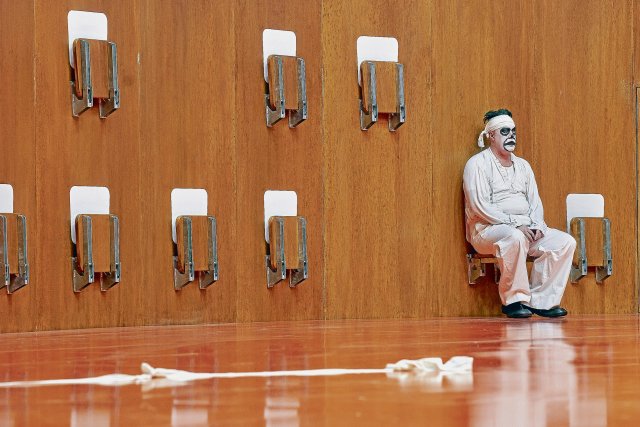Revolutionary sits, has a clown face, is close to the end: Nicholas Ofczarek plays Danton.
Photo: Matthias Horn
A favorite term of right-wing online trolls to succinctly dismiss all of the achievements of the Enlightenment since the French Revolution is “Clown World.” The clowns are clowns because they ignore the “natural order” to their own detriment. Johan Simons’ production of “Danton’s Death” in Vienna’s Burgtheater makes the turn productive for a self-criticism of left-wing historical consciousness since Georg Büchner. And also physically noticeable.
Büchner’s dramatic treatment of the conflicts of important groups such as individuals in the French Revolution takes place at the height of the so-called Reign of Terror in the spring of 1794. The stage in the Burgtheater is a circus ring that would like to be a lecture hall – or vice versa. In the prompter box there is a prompter (Ole Lagerpusch), who occasionally comes out and intervenes in the game of the rulers. At first, it seems, he is guided by the impulse that this is actually about him! him! him!, but childlike narcissism is quickly relegated to its place on the sidelines.
He will often return as an all-purpose counterpart for the actual actors in “Danton’s Death” at the Burgtheater. He will embody the miserable citizens in the street and denounce their ongoing misery, which the revolution was unable to change; he will have propaganda phrases and choreographies drummed into him by the great revolutionaries and clowns Robespierre (Michael Maertens) and Danton (Nicholas Ofczarek); and at one point in particular he will contrast or dream opposite the entire Büchner circus with the “Nachtstück” – an interlude from Heiner Müller’s play “Germania Tod in Berlin” from the 90s. Because in the “Nachstück” the image of the “human who could be a doll” is suggested even more explicitly.
We understand the arrangement: the prompter neither clearly embodies “the people” (versus the revolutionary hero in the spotlight), nor is he the spokesman for “the theory” (versus practice). And just as he is not a representative of a “present” from which the past could make sense, but rather all three, so to speak. His presence is the key to the production by Johan Simons (director) and Sebastian Huber (dramaturgy). Surprisingly, it is already enough to show us the ring in the Burgtheater as a world in which there is actually some kind of theory that can go beyond the pure law of the stronger and has any political considerations other than the biographical whims of the tyrants.
Not that this “other” would seem particularly powerful from outside to inside – the prompter as a figure is an impressively poor sausage. But at least he’s there once. This alone allows Maertens and Ofczarek, as the literal “stars in the ring”, to act out their individual quirks in a very broad and tragicomic way, without losing any of the political explosiveness and poetic complexity of Büchner’s text. Last but not least, it is precisely about the lack of individual sovereignty in the face of the “iron law, to recognize it is the highest, to control it is impossible,” as one of his letters says. Before that he writes: “The individual is just foam on the wave, the size is a mere coincidence, the rule of genius is a puppet show.” Simons and his team put this letter in the mouths of Danton’s followers at an appropriate place – a wise decision.
Consequently, the Dantonists in Simons’ circus are not heroic or even contradictory three-dimensional figures – people – but rather clowns, stage personae. Their characteristics are painted on like their faces (a few decades after Büchner, Karl Marx would coin the term “character mask”); Inevitably something happens through them and to them that cannot be changed individually through insight. You can’t get more than the fatalism of those sentenced to the guillotine within this game and this arrangement. It can be considered optimistic when, in the end, it is not only clear that the still victorious St. Just and Robespierre will soon be at the mercy of themselves, but that they themselves also look to the future as fatalistically as their victims, the Dantonists who say goodbye to each other on the way to the place of execution.
The costuming and the play between the two main characters is based on the traditionally recognizable depiction of the two people waiting for “Godot”. Ofczarek plays Danton as a coarse, slightly crouching white clown whose make-up looks like a skull even without any effort. This slight ducking is consistent with the fact that the actor also makes his voice a little smaller and more compressed (without, to be on the safe side, losing clarity even in the back rows). The resulting tension tells of an uninhibited gourmet by nature who had to “pull himself together” as a representative figure of the republic for years.
Opposite him, Maertens’ virtuous Robespierre resembles a slapstick character like Buster Keaton or Chaplin’s “Tramp” – only without the slapstick. Instead of the panic that keeps boiling up in his body being able to be relieved by playful stumbling, Robespierre can only suddenly start screaming. It’s not even very loud, this screaming, but scary. The temptation to make the good man from the northern French town of Arras sound like FPÖ leader Herbert Kickl must have been obvious; all the better that they didn’t give in to her.
So is this Danton “apolitical”? Just not. Ultimately, it is tangibly about a central demand of the Enlightenment: that politics is no longer essentially the struggle of competing gangs of robbers, essentially driven by contingent individual loyalty. But the evening is also about the fact that such a demand, since it is itself historically contingent, can quickly be withdrawn. Especially in the name of enlightenment.
It is also noticeable that all male figures except the prompter limp in one way or another, this in conjunction with costumes (by Greta Goiris), which are all asymmetrical in the upper body area, suggesting hunchbacks and/or atrophied arms. The clowns on this stage are funny or ridiculous to the extent that they successfully become caricatures of Richard III. have made, the old chief intriguer of the European theater tradition. This may also be seen as an almost optimistic statement: that they are clowns doomed to failure only to the extent that they strap on the clown nose (the clown hump) of instrumental reason.
Next performances: January 18th, January 26th, January 31st, February 3rd.
Subscribe to the “nd”

Being left is complicated.
We keep track!
With our digital promotional subscription you can read all issues of »nd« digitally (nd.App or nd.Epaper) for little money at home or on the go.
Subscribe now!
demo slot sbobet link sbobet pragmatic play
